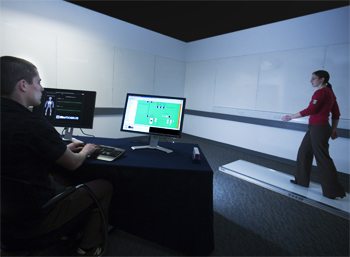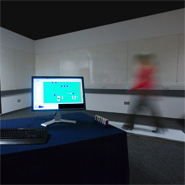Posted: 23 April 2008
Irish technology breakthrough released to global research community
TRIL technology helps research for older people
A new research platform, BioMOBIUS, has been released by an Irish intervarsity-industry research centre, TRIL, supported by Intel and backed by the Irish Industrial Development Authority (IDA). BioMOBIUS enables researchers to wirelessly link complex sensors to data-gathering hardware and date-analysing software without having to spend months working on getting the various different types of technology to talk to one another. The first version of BioMOBIUS is being made freely available to the global research community by the TRIL Centre.
Already the BioMOBIUS Research Platform is being used by TRIL researchers to help clinicians detect and treat certain conditions related to aging, such as falls and cognitive decline and to help older people strengthen their social connections.
A key challenge in health care research is the amount of time that must be devoted to technology development. “In a typical research project, 50% of a researcher’s time may be spent getting the hardware systems and the analytical software packages to interpret information gathered by monitoring equipment such as sensors,” says University College Dublin’s Dr. Aaron Quigley , an Academic Principal Investigator for the TRIL Technology Platform research strand. “Essentially every researcher has to reinvent the wheel. That’s inefficient, and it stalls research progress.”
Researchers and programme developers at UCD and Intel have developed the BioMOBIUS research platform in ‘blocks’ of code that perform certain tasks. The blocks can be reused or reconfigured to create new applications. This enables the clinical researchers spend more time focusing on their research and less on developing the technology.
The BioMOBIUS Research Platform addresses another challenge that researchers face: the complexity of sensor software. “Much health care research relies on wireless sensors to collect data, but the software that comes with these sensors usually is esoteric and quite difficult to use,” says Intel’s Michael McGrath, the Industrial Principal Investigator for the TRIL Technology Platform research strand. “You have to be a specialized programmer to use the software effectively, due to its complexity.”
The software component of the BioMOBIUS Research Platform is complex too, but the complexity is hidden from most users. The software is based on the EyesWeb graphical development environment, created at the University of Genoa, and it makes the process of creating an application intuitive.
The user drags and drops icons (blocks) onto digital drawing board. Each icon represents an input (e.g., motion data or heart rate), output (e.g., a display of a graph) or processing function. The user connects the blocks in the required order of execution to create an application. Even non-technical users can develop simple applications in a matter of minutes.
Research in practice
In one of the TRIL research projects in St. James’s Hospital in Dublin, Ireland, a team led by Trinity College Dublin’s Professor Rose Anne Kenny is investigating the impact and prevention of falls among older people using BioMOBIUS. For example, a patient who has experienced a recent fall is asked to walk along a mat that is embedded with motion sensors. She is also wearing several wireless sensors that that monitor her heart rate and the motion of her limbs as she walks across the room. Small video cameras placed around the room also track her movement.
As data is captured by the sensors and cameras, it is processed and streamed via the BioMOBIUS platform to a nearby computer. The computer screen displays a continually changing graph indicating irregularities in the woman’s gait that could lead to another fall—and a costly hospital stay. The clinical researcher viewing the screen asks the woman to slow her pace. Her gait becomes more regular and her heart rate slows. The clinician ends the experiment, gives the woman feedback on the results, and together they review a rehabilitation plan to help the woman improve her gait and hopefully, prevent another fall.

The BioMOBIUS technology gives the clinicians the ability to collect behavioural information such as movement using sensors, hand-held devices and environmental monitors; communicate that information to a central processing core; analyse it, based on the clinical models and provide feedback to the older person and their carers.
Open access helps researchers throughout the world
Making BioMOBIUS freely available throughout the world means that research teams working on many other health and environmental projects will be able to use the technology to speed up their work – leading to new therapies and processes.
The TRIL researchers hope that the BioMOBIUS community will grow and expand beyond Ireland. “We’re anxious to have researchers around the world embrace the open BioMOBIUS Research Platform,” says McGrath. “We want to build a global community of practice, with people creating and sharing new blocks and applications that others can use, so we can accelerate research progress.” As future versions of the BioMOBIUS Research Platform are released, TRIL plans to host a series of national and international workshops to promote the platform.
“The TRIL Centre is only scratching the surface of what we can do with the BioMOBIUS Research Platform, especially to empower older people,’ says Quigley. ‘Today there are 600 million people over the age of 60, and the UN projects that this figure will grow to almost two billion by 2050. Home-based applications that use the BioMOBIUS Research Platform could potentially help those two billion people to monitor their own health, remain in their own homes, and maintain their independence for as long as possible. That’s a huge opportunity to do good in the world.”
About TRIL
The TRIL (Technology Research for Independent Living) Research Centre is the largest centre in the world researching technology solutions to support independent ageing, ideally in a home environment. Its current research focuses on three areas: fall prevention, impaired cognitive function and social connection, which leads to depression. These three factors are the most common reasons for elderly people moving out of their homes and into institutional care.
TRIL combines expertise in computer science to create technology platforms (based at UCD and Intel) such as BioMOBIUS with the work of the ethnographic team based at NUI Galway to provide feedback to the engineers and scientists. The three clinical research areas are jointly led by principal investigators in the universities and in Intel Ireland.
The Centre is jointly funded by Intel Corporation and the Irish government. Intel and the Industrial Development Agency (IDA) Ireland launched the Centre in 2007, jointly investing $30 million in this three-year research initiative involving 60 researchers from Intel, University College Dublin, Trinity College Dublin and National University of Ireland (NUI) Galway.
Further information
>> http://www.trilcentre.org/
>> http://biomobius.trilcentre.org/

